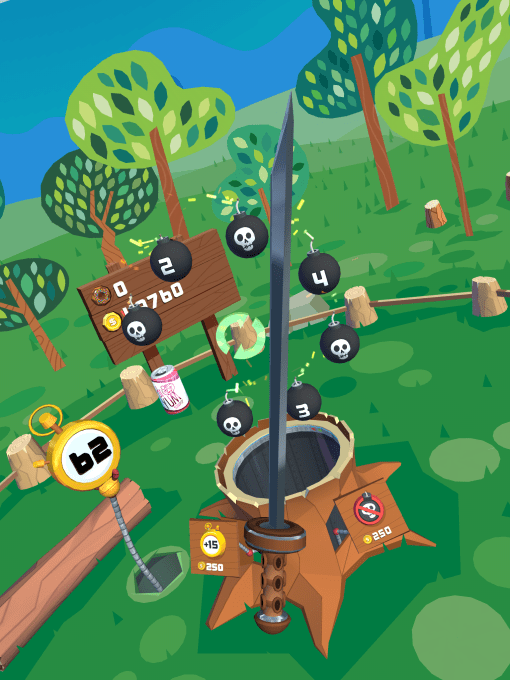A large majority of the innovation surrounding the iPhone and iPad has been focused on the touch interface. When the iOS platform was opened up in 2008, a crisp, responsive touch screen was so new and interesting that it’s not surprising it absorbed a large amount of the attention of the developer community.
We’ve seen a massive amount of experimentation and cooperative learning around exactly how ‘touch’ — including gestures, taps and more — should work. In parallel with that there was an undercurrent of work being done to poke and prod at the various other sensors that Apple has introduced over the years including the cameras, accelerometers and gyroscope. But the limits of some of those sensors haven’t been stretched and pulled nearly as much as touch has over the years.
That’s what drove Francisco Tolmasky to start building games. Because gamers, historically, have ended up being the driving force behind the rapid adoption of a good chunk of our modern computing power. So he founded Playground Theory and started building prototypes.
The roughly 20 different game concepts used a variety of interactions and sensors like touch, microphones and more. But, says Tolmasky, players kept gravitating towards one particular prototype, which consisted of an ax that would split virtual logs.
“People really liked to chop that wood,” he jokes.
That prototype led to Bonsai Slice, the game being released today. It’s a super fun mechanic that’s instantly accessible. “It’s a game that was targeted to the family iPad,” says Tolmasky, “that people can get goofy with.”
The core of Bonsai Slice is the ability to use your iPad to ‘slice’ objects hovering in midair. They shoot out of the ground and hover or rotate, encouraging you to wield your iPad like a sword, which floats out in front of you like you’re looking through a virtual GoPro attached to it by invisible beams. It’s actually a very cool and immediately instinctive mechanic that starts you out very tentative and then ramps you up until you’re slicing and dicing with a nice sense of precision and competency.
“There’s something to be said about a game that anyone can pick up and understand immediately,” Tolmasky says.

Tolmasky’s foray into games is more interesting when you get a bit of context into his history. He was recruited to Apple after Stanford and worked on the original Mobile Safari and Maps apps for the iPhone launch. After that he left and founded 280 North, a development house that crafted a set of frameworks called Cappuccino, a visual editor called Atlas and a language called Objective-J that allowed products to be built with web technologies that approximated the look and feel of native apps. 280 North was purchased by Motorola for a price TC reported to be around $20M.
Being steeped in the mobile touch world since it got its first real injection of mass adoption means that Tolmasky is coming at this with a long record of seeing how intensely the problem of ‘touch’ was attacked by first- and third-party developers. The other sensors in these devices, he feels, haven’t gotten enough attention and exploration.
The gyroscope, introduced to Apple’s tablets with the iPad 2, is essential to Bonsai Slice’s gameplay. Tolmasky says there was a ton of work done to get the play running at a buttery smooth 60 FPS, with no drift in the sensor and a high amount of sensitivity.
The effect of that work is a fun game that makes you feel like you’re wielding a sword. There was a lot of tweaking done to give it the ‘feel’ of a 1:1 interaction with the weapon, even though that’s not technically or spatially possible without having you running around knocking things over with your iPad. Still, the game makes good use of your immediate 3D space, floating objects around you in 360 degrees — giving the iPad the role of a viewport into another world. At times, you’ll need to rotate completely around to slice all of the objects presented to you.
Tolmasky jokes that it’s not the kind of game that you’ll be playing on the subway, but I wouldn’t count that out completely.
Bonsai Slice is gorgeous, with designs created by an ex-Disney artist. It’s a beautiful, bright look that fits the playful nature of the game well.
There is a sense of progression in the game as well, as you can gather coins to unlock new swords with special abilities. It’s launching at $2.99, with some in-app purchases if you’d like to unlock the swords or boosts without having to earn the coins in game.
A multiplayer mode allows you and a friend to battle it out to slice the most objects in head-to-head via WiFi or online vs. a randomly selected opponent. Leaderboards give you an immediate sense of where you’re scoring in comparison to other players and a reason to continue.
It’s very fun, and certainly unlike any game I’ve played before. I’m really pleased with the way that the final game turned out as well, having played the early wood chopping prototype some time ago. It was fun then, and it’s even better with an actual game around it.
When I ask Tolmasky what his long-term vision of success for Bonsai Slice is, he says it would be seeing other games adopt the mechanic. In other words, spurring developers to explore the variety of other sensors and interaction possibilities in the iPhone and iPad just as much as they have with ‘touch’.
You can snag Bonsai Slice on the App Store.
